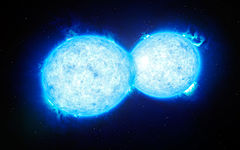astro.wikisort.org - Star
In astronomy, a contact binary is a binary star system whose component stars are so close that they touch each other or have merged to share their gaseous envelopes. A binary system whose stars share an envelope may also be called an overcontact binary.[1][2] The term "contact binary" was introduced by astronomer Gerard Kuiper in 1941.[3] Almost all known contact binary systems are eclipsing binaries;[4] eclipsing contact binaries are known as W Ursae Majoris variables, after their type star, W Ursae Majoris.[5]

In a contact binary, both stars have filled their Roche lobes, allowing the more massive primary component to transfer both mass and luminosity to the secondary member. As a result, the components in a contact binary often have similar effective temperatures and luminosities, regardless of their respective masses. The rate of energy transfer between the components is dependent on their mass ratio and luminosity ratio. In cases where the stars are in geometric contact but the thermal contact is poor, there can exist wide differences between their respective temperatures.[6]
Contact binaries are not to be confused with common envelopes. Whereas the configuration of two touching stars in a contact binary has a typical lifetime of millions to billions of years, the common envelope is a dynamically unstable phase in binary evolution that either expels the stellar envelope or merges the binary in a timescale of months to years.[7]
See also
- Contact binary (small Solar System body), two asteroids gravitating toward each other until they touch.
- HR 5171, a yellow hypergiant and yellow supergiant contact binary with a third star orbiting further out.
- KIC 9832227, a contact binary and a previous candidate for stellar merger.
- Luminous red nova, e.g. V1309 Scorpii (2008), may result from the merger of a contact binary.
- Thorne–Żytkow object, a type of star wherein a red giant or supergiant contains a neutron star at its core.
- VFTS 352, a massive contact binary in the Tarantula Nebula.
References
- Darling, David. "binary star". www.daviddarling.info. Retrieved 2019-05-06.
- Thompson, Michael J. (2006). An Introduction to Astrophysical Fluid Dynamics. London: Imperial College Press. pp. 51–53. ISBN 1-86094-615-1.
- Kuiper, Gerard P. (1941). "On the Interpretation of β Lyrae and Other Close Binaries". Astrophysical Journal. 93: 133. Bibcode:1941ApJ....93..133K. doi:10.1086/144252.
- Tassoul, Jean Louis; et al. (2000). Stellar Rotation. Cambridge, UK, New York: Cambridge University Press. p. 231. ISBN 0-521-77218-4.
- Mullaney, James (2005). Double and Multiple Stars and how to Observe Them. New York, London: Springer. p. 19. ISBN 1-85233-751-6.
- Csizmadia, Sz.; Klagyivik, P. (November 2004). "On the properties of contact binary stars". Astronomy and Astrophysics. 426: 1001–1005. arXiv:astro-ph/0408049. Bibcode:2004A&A...426.1001C. doi:10.1051/0004-6361:20040430.
- Ivanova, N.; et al. (2013). "Common envelope evolution: where we stand and how we can move forward". The Astronomy and Astrophysics Review. 21: 59. arXiv:1209.4302. Bibcode:2013A&ARv..21...59I. doi:10.1007/s00159-013-0059-2.
На других языках
- [en] Contact binary
[es] Estrella binaria de contacto
En astronomía se denomina binaria de contacto a una estrella binaria cuyas componentes están tan próximas que llenan sus lóbulos de Roche,[1] llegando a tocarse o a fusionarse de manera que comparten su capa exterior de gas. Un sistema binario en donde ambas componentes comparten las capas exteriores puede llamarse «binaria de sobrecontacto» (overcontact binary en inglés).[2][3] Prácticamente todas las binarias de contacto son binarias eclipsantes;[4] las binarias eclipsantes de contacto son conocidas como variables W Ursae Majoris, cuyo arquetipo es la estrella W Ursae Majoris.[5][ru] Тесная двойная система
Тесные двойные системы — разновидность двойных систем, в которых на тех или иных этапах своей эволюции входящие в неё компоненты могут обмениваться массой. Расстояние между звездами в тесной двойной системе сравнимо с размерами самих звёзд. Поэтому в таких системах возникают более сложные эффекты, чем просто притяжение: приливное искажение формы, прогрев излучением более яркого компаньона и т. д. Обмен веществом вносит существенные коррективы в ход звёздной эволюции, поэтому компоненты тесных двойных систем эволюционируют совсем не так, как обычные звёзды. Особенно интересны системы, в которых один из компонентов находится на завершающей стадии эволюции[1].Другой контент может иметь иную лицензию. Перед использованием материалов сайта WikiSort.org внимательно изучите правила лицензирования конкретных элементов наполнения сайта.
WikiSort.org - проект по пересортировке и дополнению контента Википедии